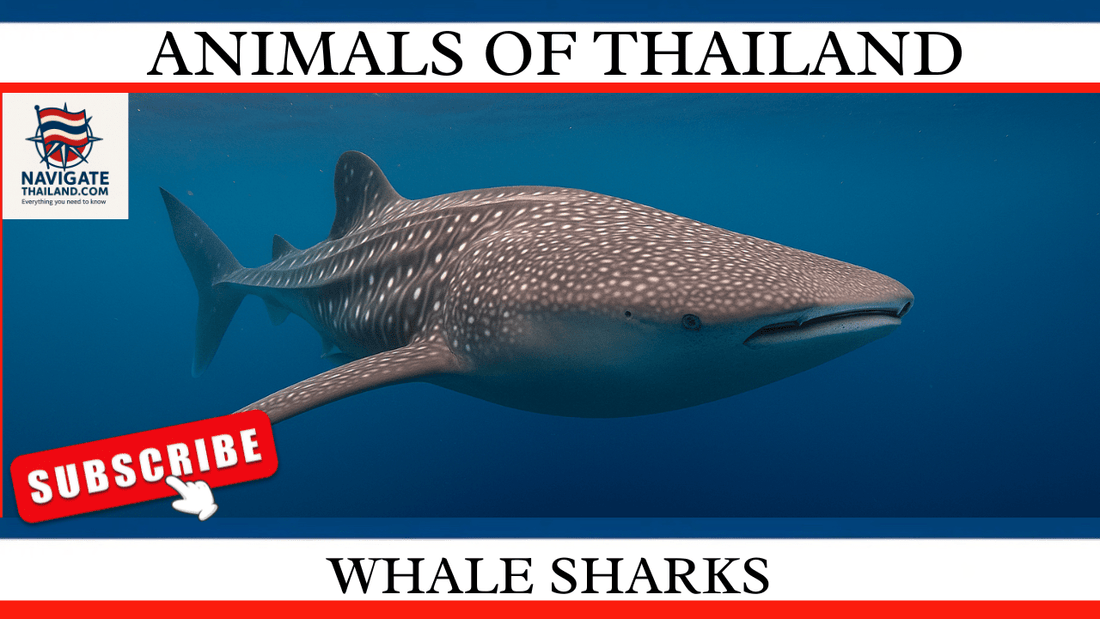
Whale sharks: The biggest fish in the ocean
Share
Thailand’s crystal-clear waters and vibrant marine ecosystems make it one of the most popular destinations for divers and marine enthusiasts from around the globe. Among the treasures of these tropical seas is the majestic whale shark (Rhincodon typus), the largest fish in the ocean. Despite their immense size, whale sharks are gentle giants, captivating all who are fortunate enough to encounter them.
In this blog, we’ll dive into the fascinating world of whale sharks in Thailand, exploring their size, diet, habitat, and why Thailand is one of the best places to see them. We’ll also look at the conservation efforts in place to protect these magnificent creatures and some fun facts that will deepen your appreciation for the world’s biggest fish.
What Are Whale Sharks?
Whale sharks, despite their name, are not whales but the largest species of fish in the ocean. These massive filter feeders belong to the elasmobranch family, which also includes other sharks and rays. Known for their characteristic wide mouths and spotted skin, whale sharks are a sight to behold.
How Big Do Whale Sharks Get?
Whale sharks are truly enormous. On average, they grow up to 12 metres (39 feet) long, but the largest individuals can reach up to 18 metres (59 feet), making them longer than a school bus! These gentle creatures can weigh as much as 20 tonnes.
Their sheer size is matched by their grace. Whale sharks are slow swimmers, gliding through the water at a leisurely pace of around 5 km/h (3 mph), allowing snorkelers and divers in Thailand the chance to get up close to these magnificent animals.
Fun Fact: Despite their enormous size, whale sharks have thousands of tiny teeth, though they don’t use them for feeding!
Where Can You Find Whale Sharks in Thailand?
Thailand is home to some of the best whale shark diving spots in the world. These creatures are typically found in tropical and warm-temperate seas, and the Andaman Sea and the Gulf of Thailand are prime areas for whale shark sightings. Whale sharks are migratory creatures, often travelling long distances to feed and reproduce, but they frequently visit specific locations in Thailand known for their nutrient-rich waters.
Top Spots to See Whale Sharks in Thailand:
• Koh Tao: Koh Tao is one of the best places in Thailand to swim with whale sharks. Known for its fantastic diving sites, including Chumphon Pinnacle and Southwest Pinnacle, this island in the Gulf of Thailand offers a high chance of spotting these gentle giants, especially between March and May.
• Sail Rock: Located between Koh Phangan and Koh Tao, Sail Rock is another hotspot for whale shark encounters. Its unique underwater topography attracts large pelagic fish, including whale sharks.
• Richelieu Rock: This iconic dive site in the Andaman Sea, near the Similan Islands, is considered one of the top spots in the world for whale shark sightings. The nutrient-rich waters here attract a variety of marine life, including the elusive whale shark, particularly from February to April.
• Hin Daeng and Hin Muang: These dive sites in the southern Andaman Sea near Koh Lanta are known for deep dives and rich marine biodiversity. Whale sharks are occasionally seen here, making it an exciting spot for divers hoping for a memorable encounter.
What Do Whale Sharks Eat?
Despite their enormous size, whale sharks feed on some of the smallest organisms in the ocean. These gentle giants are filter feeders, which means they swim through the water with their mouths wide open, collecting plankton, small fish, and crustaceans.
Feeding Techniques
Whale sharks use two primary methods to feed:
1. Ram Feeding: In this technique, whale sharks swim with their mouths open, allowing water and food to flow in. The water is then filtered out through their gills, and the plankton and small fish are trapped inside.
2. Suction Feeding: Whale sharks can also suck water into their mouths, which allows them to feed in areas where food is more concentrated.
These sharks can filter around 6,000 litres of water every hour, making them highly efficient feeders!
Fun Fact: Unlike most sharks, which are known for their sharp teeth, whale sharks have tiny teeth that they don’t use for feeding. Instead, they rely on their gill rakers to filter their food.
Why Do Whale Sharks Migrate to Thailand?
Whale sharks are highly migratory, travelling thousands of kilometres to follow their food sources. Thailand’s warm, nutrient-rich waters provide the perfect conditions for plankton blooms, which attract whale sharks.
Certain times of the year are better for spotting these giants, as whale sharks are more likely to visit Thailand during plankton blooms or coral spawning events. In places like Richelieu Rock or Sail Rock, whale sharks can often be seen during the months of February to May, when the plankton levels are at their highest.
Why Do Whale Sharks Visit Specific Dive Sites?
Whale sharks are known to visit specific sites year after year, drawn to the abundance of food. These locations, like Richelieu Rock, are often characterised by strong currents that bring nutrient-rich water to the surface, supporting a thriving marine ecosystem. The abundance of plankton and small fish creates a perfect feeding ground for whale sharks.
The Importance of Whale Shark Conservation
Whale sharks are classified as “Endangered” on the IUCN Red List due to threats from human activity. While they are protected under international law, they face threats from:
• Fishing: Whale sharks are often caught accidentally as bycatch in commercial fisheries. In some parts of the world, they are also hunted for their fins, meat, and oil.
• Boat Strikes: As whale sharks often swim near the surface, they are vulnerable to being struck by boats, which can cause severe injuries or death.
• Tourism: While swimming with whale sharks can be an incredible experience, irresponsible tourism practices can cause harm to these gentle creatures. It’s essential for tour operators to follow ethical guidelines, ensuring that whale sharks are not disturbed or harmed.
Conservation Efforts in Thailand
Thailand has become a leader in whale shark conservation, with several organisations working to protect these gentle giants. Marine parks like the Similan Islands National Park enforce strict regulations to protect marine life, including whale sharks. In addition, many dive centres in Thailand actively promote responsible tourism, ensuring that interactions with whale sharks are conducted in a way that does not harm them.
Research is also ongoing to better understand whale shark populations in Thailand. Scientists use photographic identification to track individual sharks, studying their migration patterns and behaviour. The unique pattern of spots on each whale shark acts like a fingerprint, allowing researchers to identify and monitor these animals over time.
Fun Facts About Whale Sharks
• Whale Sharks Have Unique Spots: Every whale shark has a unique pattern of spots on its body, much like human fingerprints. Researchers use these patterns to identify and track individual sharks.
• Whale Sharks Are Slow but Powerful: Despite their slow cruising speed, whale sharks are capable of diving to depths of over 1,000 metres (3,280 feet).
• Long Lifespan: Whale sharks are believed to live for up to 70-100 years, making them one of the longest-living fish species in the ocean.
• Whale Shark Babies: Female whale sharks give birth to live young, known as pups. However, very little is known about their breeding habits, as pregnant females are rarely observed.
Why Whale Sharks Matter
Whale sharks play a vital role in maintaining the health of marine ecosystems. As filter feeders, they help regulate plankton populations, which are essential to the marine food web. Additionally, their presence in areas like Thailand’s marine parks helps support local economies through eco-tourism.
By protecting whale sharks and their habitats, we help ensure the long-term health of marine ecosystems and the survival of one of the ocean’s most incredible creatures.
Final Thoughts
Whale sharks are truly one of the ocean’s most majestic creatures, and Thailand offers some of the best opportunities in the world to encounter these gentle giants. However, as we enjoy the privilege of swimming with these creatures, it’s crucial to support conservation efforts and promote responsible tourism practices that protect them for future generations.
References
1. WWF - “Whale Sharks: Gentle Giants of the Ocean”
2. Marine Megafauna Foundation - “Whale Shark Research and Conservation”
3. National Geographic - “Everything You Need to Know About Whale Sharks”
4. Thailand Dive and Sail - “Best Dive Sites to See Whale Sharks in Thailand”
Read more of our Thailand blog series:
Thai Food Guide:Traditional Recipes and Street Eats
Everything Travellers Need to know
Thailand travel ebooks and language guides
Thailand Travel Apparel & Souvenir Gifts
Subscribe to our YouTube channel Navigate Thailand to see our most popular Thailand travel blogs turned into videos:
Navigate Thailand YouTube channel


















































































































































